Published Nov 17, 2013
Writer's Log #2: Mike Johnson Takes You Behind The Panels of IDW's Khan Comics
Writer's Log #2: Mike Johnson Takes You Behind The Panels of IDW's Khan Comics
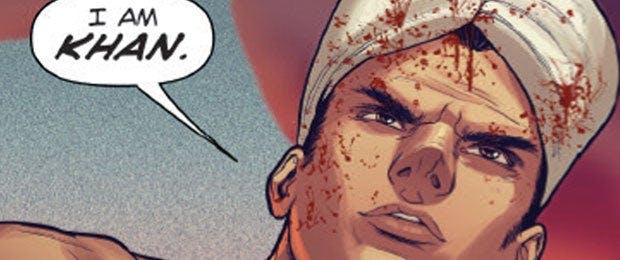
Welcome to another installment of Writer’s Log, a behind-the-panels look at the creation of the five-issue STAR TREK: KHAN mini-series from IDW Publishing. I’m series writer Mike Johnson, and in this log entry we’ll be discussing a few key panels from KHAN #2, now available in stores and online. Sensors detect spoilers ahead!
PAGE 1, PANELS 3 & 4
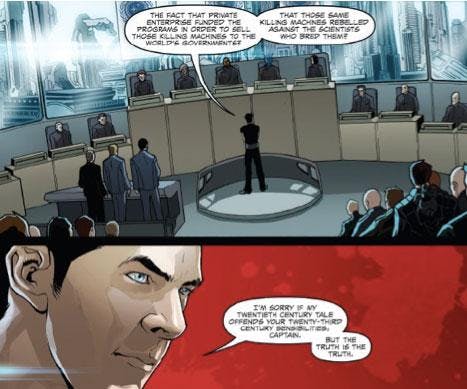
We open on Khan’s trial in progress after the events of STAR TREK INTO DARKNESS, with art in this scene by David Messina. Framing Khan’s origin story with his trial gives us a chance to link the series with the new movie universe in a visual way, and gives fans a look at what transpired in the time between his capture by Spock and Uhura in INTO DARKNESS and his return to suspended animation at the end of the movie. Later in the series we will see exactly what led to the decision to “re-freeze” him.
PAGE 2, PANEL 2:
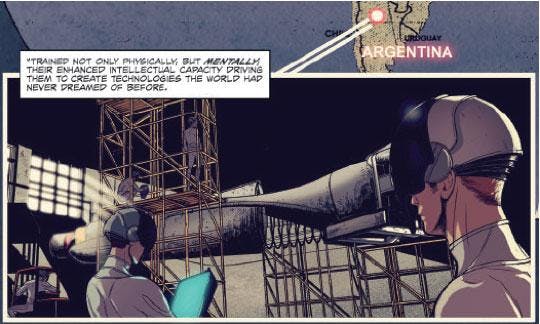
Here we see one of the Augment “schools” scattered in secret locations around the world, prior to the Augments’ global takeover. Claudia Balboni is our artist on all of the flashback sequences, and here she envisions the mix of 20th and 21st century technology that characterizes the Augments’ scientific advances.
Using the Original Series episode “Space Seed” as reference, we know that the Augments seized power simultaneously in over forty nations. In developing the story we see here, we extrapolated that the Augments would be preparing in more than just one locale, and that they would be developing weapons and technology that would give them an advantage over existing armies beyond just their superior physical strength and endurance.
PAGE 4, PANEL 2:
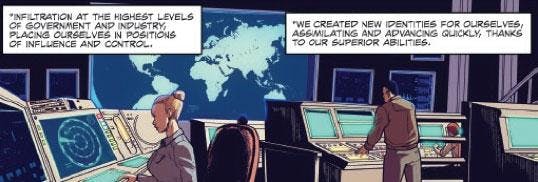
Rome wasn’t built in a day, and neither was the Augment takeover. It took years of planning and coordination to prepare for a global revolution. Posing as “normal” humans, the Augments assumed key positions in the political and military infrastructures of countries around the world. Their superior intellects ensured that they would rise quickly through the ranks to acquire access to and responsibility for the very means by which countries would defend themselves in the event of an attack.
PAGE 5, PANEL 2:
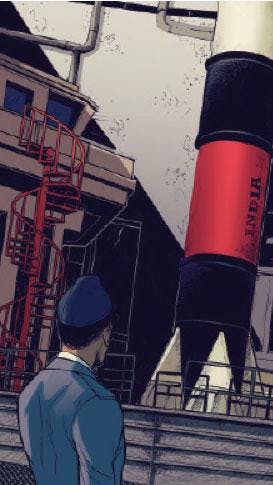
The ultimate measure of a nation’s power in the late 20th century (but not the 23rd, thankfully) was the possession of nuclear arsenal. The Augments’ highest priority was to control those arsenals in every country. Here we see Khan back in his native India, having joined the nation’s Air Force and now working within its nuclear program.
Focusing on the nuclear aspect of the Augments’ takeover was inspired in part by the fact that the original series was created in the midst of the Cold War. One of STAR TREK’s greatest achievements has always been its ability to mirror our present world in stories of the future, and nowhere is that more clear in the series’ refusal to ignore the climate of international tension that characterized the Cold War. We see it reflected in powerful allegories such as the first encounter between the Federation and the Klingons in “Errand of Mercy,” and in encounters with world-ending threats like “The Doomsday Machine”.
PAGE 10, PANEL 1:

Here we see that the nuclear nightmare of the Cold War did in fact take place within the timeline of the STAR TREK universe, but not as a result of conflict between the United States and the Soviet Union. The Augments were responsible. Their attacks on Moscow and Washington D.C. signaled the beginning of their worldwide takeover.
Initially we discussed the Augments launching a singular attack on New York City, but in developing the story we realized that an attack on the capitals of the Cold War, the two most powerful nations of the time, was both logical and appropriately symbolic. Logical in that the attacks would immediately reset the balance of power in the world and create a void that the Augments could fill themselves, and symbolic in that the ascension of the Augments represented the end of our historical timeline and the beginning of the new one that leads to the 23rd century as we know it in STAR TREK.
This was the biggest point of discussion in developing the story: whether to make a clean break from “our” timeline, or whether to attempt to preserve history as we know it from the “real” 1990’s and early 2000’s. Ultimately the deciding factor was to embrace canon as we know it from STAR TREK itself, and in “Space Seed” it is clear that the 1990’s did not play out as we lived them. It’s a question that every story set in a specified future time period has to address eventually, given that our present will eventually catch up to it on the calendar. In fact, we’re only fifty years away from first contact with the Vulcans!
PAGE 11, PANEL 4:

The Augments didn’t just assume control of the nuclear arsenals. They seized the airwaves, broadcasting worldwide to announce that the world had changed forever. This beat was inspired by another 20th century concept: that of a totalitarian “Big Brother,” to use the phrase coined by George Orwell in his novel 1984. The Augments were not just content to manipulate events behind the scenes. Their goal was to rule, publically and completely.
The Augments’ commitment to absolute power is apparent from the first time we meet Khan in the original series. Behind his charming demeanor is a conviction that his way is not just the best way, but the only way, to the extent that even the captain of a starship is just another inconvenient obstacle to his ultimate goal.
PAGE 15, PANEL 4:

We could devote all five issues of the series just to the rise of the Augments, but given that we have many years (and as we will see, many light-years) to cover, we opted to show “snapshots” of the events as they unfolded. From the Forbidden City to the Houses of Parliament, we witness the devastation caused by the Augments as they eliminate all opposition. The suggestion in the panel above that even opposing sides in the Middle East could find common ground in the face of the Augment threat is inspired by the inherent optimism that always characterized STAR TREK. As apocalyptic as the Eugenics Wars and the subsequent Third World War proved to be, we know that humanity not only survived, but came together as one to create the bright future that exists in the 23rd century.
PAGE 16, PANEL 2:

We decided on a single, simple design for all of the Augments uniforms. Their superior strength means that they do not need helmets or body armor to protect themselves, and the basic white evokes the laboratories in which their enhanced genetics were developed. The fact that they wear identical uniforms reflects both their unified goal of world domination and their origin as “blank slates” without individual eccentricities or ambitions… yet…
PAGE 19, PANELS 2, 3 & 4:
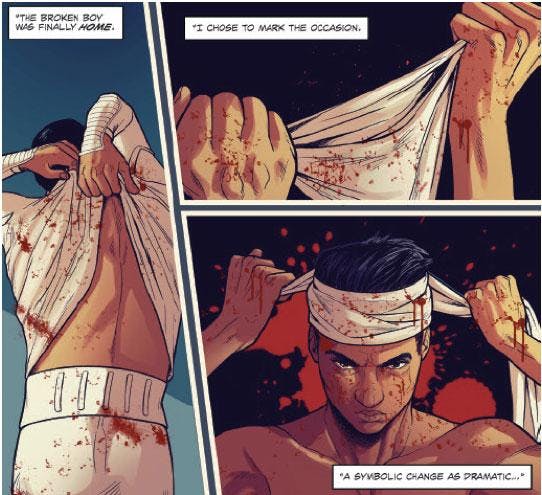
Noonien leads the takeover of Central Asia, including the Indian subcontinent, and it is only fitting that the battle ends in the city from which he was taken as a crippled child by the Augment program. Up to this point he has been satisfied with being one of many, a loyal part of the Augment revolution whose only ambition is to see those like him come to power. Here, having returned to where his journey began, we see him take his first step towards an identity of his own. He rips his Augment uniform apart and transforms it…
PAGE 22:
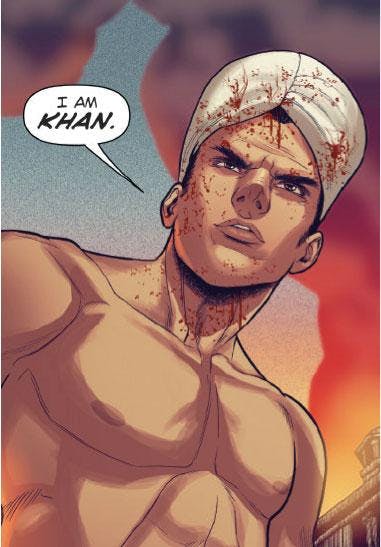
… into an echo of an iconic STAR TREK image, the painting of Khan in his turban as seen in “Space Seed.” It is the moment that he adopts the name “Khan,” a centuries-old title used by rulers of Central Asia. The choice of the name reflects his burning ambition to rule, but it also marks the end of one chapter of his life and the beginning of another, as we will see in the next issue.
We hope you’ll join us next month for an inside look at STAR TREK: KHAN #3, as the Eugenics Wars escalate, and Khan embarks on a new journey that will take him all the way to the 23rd century…
Until then, as always: live long and prosper!

